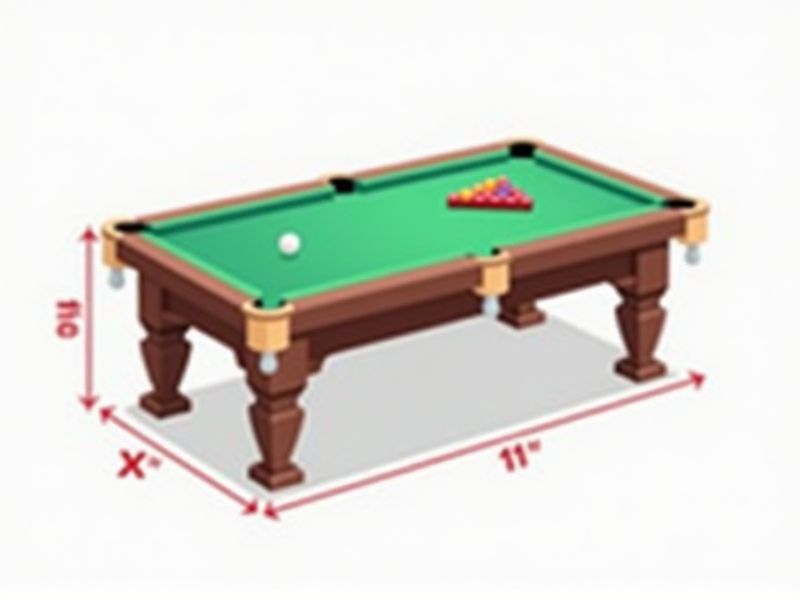
A standard billiard table used for most professional pool games is typically 9 feet long by 4.5 feet wide (274 cm by 137 cm). The playing surface, measured from the inside edges of the cushions, is the area referred to with these dimensions. For home use or recreational spaces, you may also find 7-foot or 8-foot tables, but 9-foot is the professional benchmark. Always verify the available space in your room, as you'll need extra clearance around the table for comfortable cueing.
Regulation Size
The regulation size for a billiard table is typically 9 feet by 4.5 feet, which is the official dimension used in tournaments sanctioned by the World Pool-Billiard Association. For recreational play, 7-foot and 8-foot tables are also common, with dimensions of 7 feet by 3.5 feet and 8 feet by 4 feet, respectively. The weight of a standard slate bed, which provides a smooth playing surface, can range from 600 to 1,200 pounds depending on the size of the table. Your choice of table size affects gameplay dynamics, cue ball control, and the overall experience of skill development.
Length-To-Width Ratio
The standard length-to-width ratio for a billiard table is typically 2:1, ensuring optimal playability and aesthetics. For example, a regulation 9-foot table measures 100 inches in length and 50 inches in width, while a 7-foot table measures 84 inches in length and 42 inches in width. This ratio contributes to the dynamics of the game, allowing for precise shots and strategic play. Your choice of table dimensions can significantly influence your billiards experience, affecting everything from shot angles to overall gameplay.
Playing Surface Dimensions
A standard billiard table features a playing surface that measures 9 feet by 4.5 feet for tournament play, with pocket dimensions typically ranging from 4.5 inches to 5 inches in diameter. The cloth covering the surface is generally made of woolen or synthetic material, designed to provide a smoother playing experience. A regulation table has a height of around 2.5 feet, ensuring accessibility for players of various heights. Proper maintenance of these dimensions is crucial for ensuring fair play and enhancing overall performance in competitive settings.
Rail Width
The standard rail width for a billiard table typically measures between 5 to 6 inches, promoting optimal ball bounce and control. This dimension is crucial, as it directly influences gameplay dynamics and player strategies. With a consistent rail width, you enhance your chances of making precise shots and executing complex bank shots. Understanding this standard can significantly improve your performance in cue sports, providing a competitive edge at various skill levels.
Pocket Sizes
The standard pocket sizes for a regulation billiard table vary based on the game, with pockets typically measuring between 4.5 inches to 5 inches wide. For tournament play, a 4.5-inch pocket size is common in professional pocket billiards. In contrast, recreational or home tables might feature larger pockets up to 5 inches, accommodating players of all skill levels. Understanding the significance of pocket size can help you select the right table for your playing style, enhancing your overall billiards experience.
Cushion Angle
Cushion angle on a standard billiard table significantly influences gameplay, affecting ball rebound and trajectory. Typically, the cushion angle measures around 30 degrees, optimizing a player's ability to calculate shots accurately. High-quality tables often feature natural rubber cushions, enhancing elasticity and durability, ensuring consistent performance over time. Understanding the intricacies of cushion angle can improve your strategic approach, allowing for more precise shot-making in competitive settings.
Bed Height
The standard height of a billiard table bed is typically between 28 to 32 inches. This height ensures optimal playability and comfort for players of various heights. The bed, which is the flat playing surface, is crucial for consistent ball behavior, with a standard size of 88 inches by 44 inches for a regulation pool table. You may also notice that professional tables have specific regulations regarding felt type and cushion response, which further enhance your gameplay experience.
Slate Thickness
The standard billiard table typically features a slate thickness of 1 inch (2.54 cm) to ensure a level and stable playing surface. Some high-end models may utilize 1.5 inches (3.81 cm) of slate, providing even greater durability and precision in gameplay. Choose a table that uses premium-grade, three-piece slate, which contributes to improved flatness and reduced warping over time. Investing in a quality slate table enhances your overall billiards experience, offering seamless ball movement and consistent shot accuracy.
Table Height
A standard billiard table height typically ranges from 28 to 32 inches, ensuring optimal comfort and playability. The height is crucial as it affects your posture and stroke accuracy during gameplay. For professional tournaments, a height of 29.5 inches is commonly preferred, aligning with regulations set by organizations such as the World Pool-Billiard Association. Ensuring your table meets these height specifications can significantly enhance your playing experience and performance.
Lighting Clearance
The lighting clearance for a standard billiard table should be a minimum of 60 inches above the playing surface to ensure optimal visibility and reduce shadows. Ideally, a fixture illuminating the table should provide around 300 to 400 lux of brightness, enhancing your gameplay experience. It's also important to use focused lighting rather than diffuse to maintain clarity for ball identification. When setting up your billiard area, consider the placement of fixtures to avoid glare and maintain even light distribution across the table.
